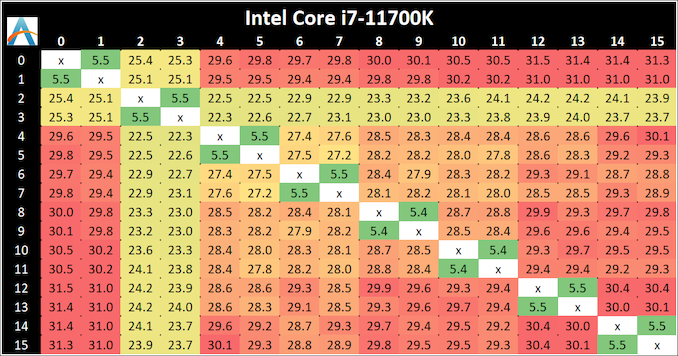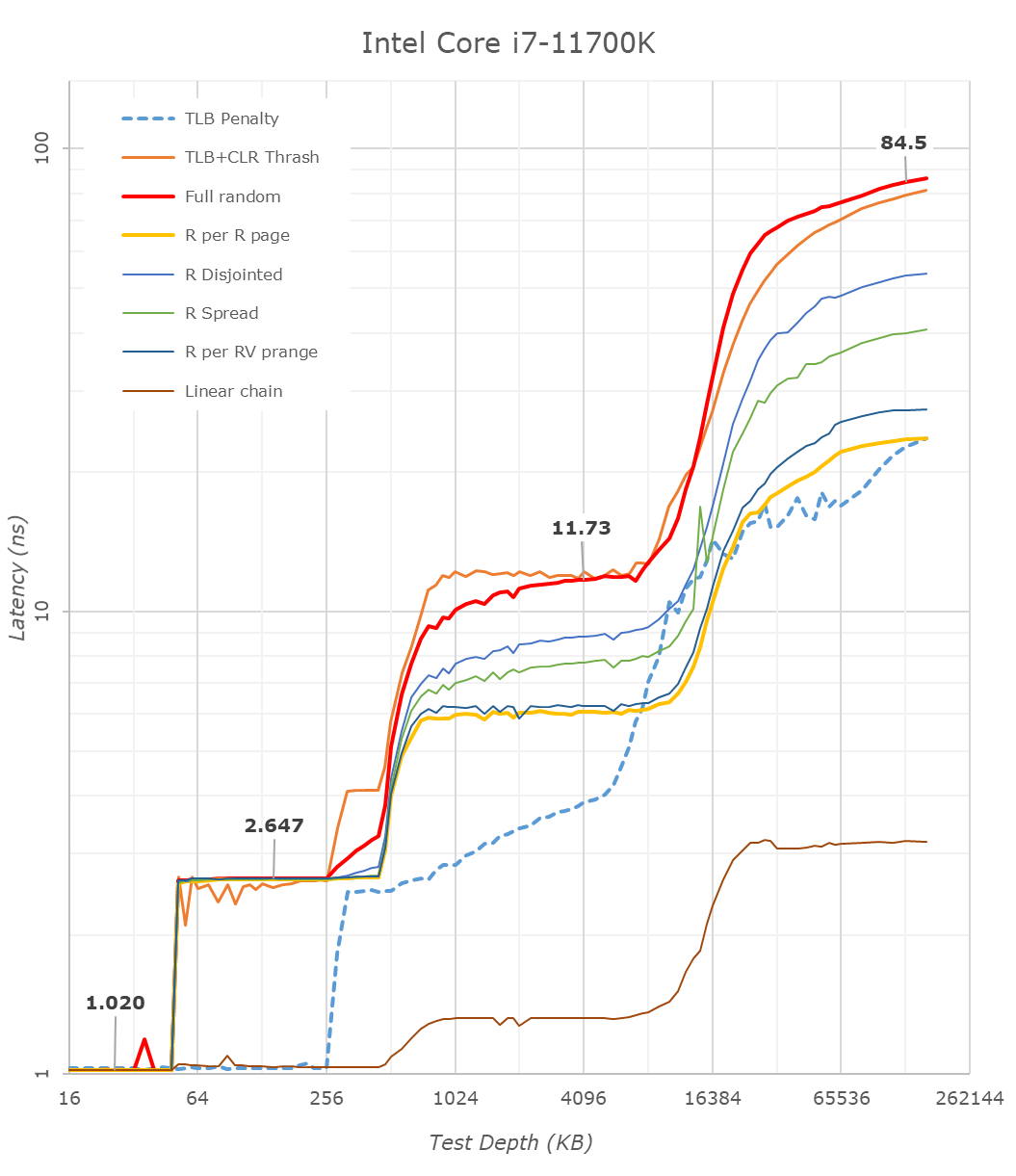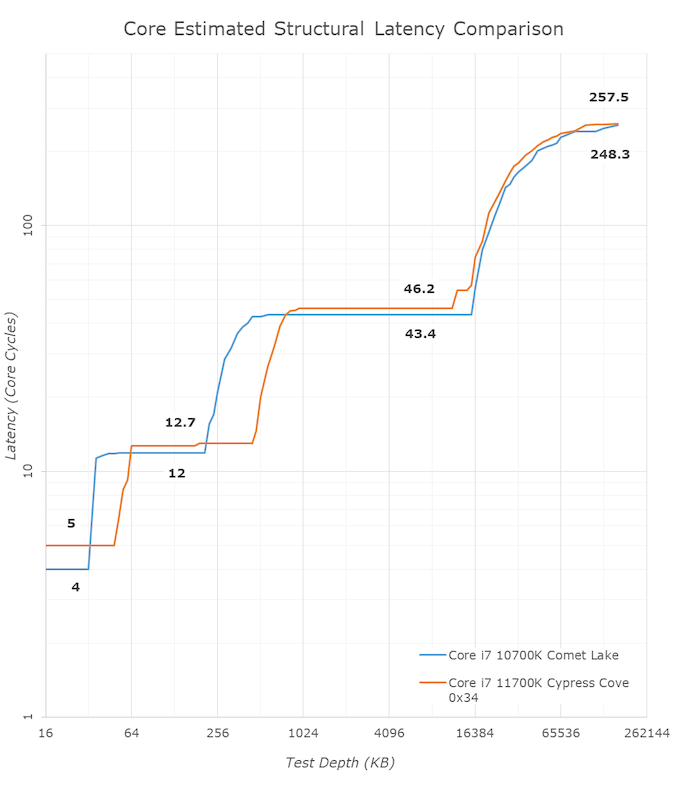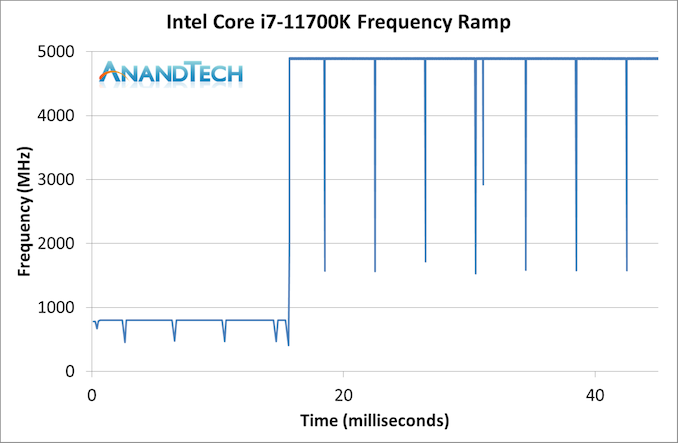Intel Core i7-11700K Review: Blasting Off with Rocket Lake
by Dr. Ian Cutress on March 5, 2021 4:30 PM EST- Posted in
- CPUs
- Intel
- 14nm
- Xe-LP
- Rocket Lake
- Cypress Cove
- i7-11700K
CPU Tests: Microbenchmarks
Core-to-Core Latency
As the core count of modern CPUs is growing, we are reaching a time when the time to access each core from a different core is no longer a constant. Even before the advent of heterogeneous SoC designs, processors built on large rings or meshes can have different latencies to access the nearest core compared to the furthest core. This rings true especially in multi-socket server environments.
But modern CPUs, even desktop and consumer CPUs, can have variable access latency to get to another core. For example, in the first generation Threadripper CPUs, we had four chips on the package, each with 8 threads, and each with a different core-to-core latency depending on if it was on-die or off-die. This gets more complex with products like Lakefield, which has two different communication buses depending on which core is talking to which.
If you are a regular reader of AnandTech’s CPU reviews, you will recognize our Core-to-Core latency test. It’s a great way to show exactly how groups of cores are laid out on the silicon. This is a custom in-house test built by Andrei, and we know there are competing tests out there, but we feel ours is the most accurate to how quick an access between two cores can happen.
The core-to-core numbers are interesting, being worse (higher) than the previous generation across the board. Here we are seeing, mostly, 28-30 nanoseconds, compared to 18-24 nanoseconds with the 10700K. This is part of the L3 latency regression, as shown in our next tests.
One pair of threads here are very fast to access all cores, some 5 ns faster than any others, which again makes the layout more puzzling.
Update 1: With microcode 0x34, we saw no update to the core-to-core latencies.
Cache-to-DRAM Latency
This is another in-house test built by Andrei, which showcases the access latency at all the points in the cache hierarchy for a single core. We start at 2 KiB, and probe the latency all the way through to 256 MB, which for most CPUs sits inside the DRAM (before you start saying 64-core TR has 256 MB of L3, it’s only 16 MB per core, so at 20 MB you are in DRAM).
Part of this test helps us understand the range of latencies for accessing a given level of cache, but also the transition between the cache levels gives insight into how different parts of the cache microarchitecture work, such as TLBs. As CPU microarchitects look at interesting and novel ways to design caches upon caches inside caches, this basic test proves to be very valuable.
Looking at the rough graph of the 11700K and the general boundaries of the cache hierarchies, we again see the changes of the microarchitecture that had first debuted in Intel’s Sunny Cove cores, such as the move from an L1D cache from 32KB to 48KB, as well as the doubling of the L2 cache from 256KB to 512KB.
The L3 cache on these parts look to be unchanged from a capacity perspective, featuring the same 16MB which is shared amongst the 8 cores of the chip.
On the DRAM side of things, we’re not seeing much change, albeit there is a small 2.1ns generational regression at the full random 128MB measurement point. We’re using identical RAM sticks at the same timings between the measurements here.
It’s to be noted that these slight regressions are also found across the cache hierarchies, with the new CPU, although it’s clocked slightly higher here, shows worse absolute latency than its predecessor, it’s also to be noted that AMD’s newest Zen3 based designs showcase also lower latency across the board.
With the new graph of the Core i7-11700K with microcode 0x34, the same cache structures are observed, however we are seeing better performance with L3.
The L1 cache structure is the same, and the L2 is of a similar latency. In our previous test, the L3 latency was 50.9 cycles, but with the new microcode is now at 45.1 cycles, and is now more in line with the L3 cache on Comet Lake.
Out at DRAM, our 128 MB point reduced from 82.4 nanoseconds to 72.8 nanoseconds, which is a 12% reduction, but not the +40% reduction that other media outlets are reporting as we feel our tools are more accurate. Similarly, for DRAM bandwidth, we are seeing a +12% memory bandwidth increase between 0x2C and 0x34, not the +50% bandwidth others are claiming. (BIOS 0x1B however, was significantly lower than this, resulting in a +50% bandwidth increase from 0x1B to 0x34.)
In the previous edition of our article, we questioned the previous L3 cycle being a larger than estimated regression. With the updated microcode, the smaller difference is still a regression, but more in line with our expectations. We are waiting to hear back from Intel what differences in the microcode encouraged this change.
Frequency Ramping
Both AMD and Intel over the past few years have introduced features to their processors that speed up the time from when a CPU moves from idle into a high powered state. The effect of this means that users can get peak performance quicker, but the biggest knock-on effect for this is with battery life in mobile devices, especially if a system can turbo up quick and turbo down quick, ensuring that it stays in the lowest and most efficient power state for as long as possible.
Intel’s technology is called SpeedShift, although SpeedShift was not enabled until Skylake.
One of the issues though with this technology is that sometimes the adjustments in frequency can be so fast, software cannot detect them. If the frequency is changing on the order of microseconds, but your software is only probing frequency in milliseconds (or seconds), then quick changes will be missed. Not only that, as an observer probing the frequency, you could be affecting the actual turbo performance. When the CPU is changing frequency, it essentially has to pause all compute while it aligns the frequency rate of the whole core.
We wrote an extensive review analysis piece on this, called ‘Reaching for Turbo: Aligning Perception with AMD’s Frequency Metrics’, due to an issue where users were not observing the peak turbo speeds for AMD’s processors.
We got around the issue by making the frequency probing the workload causing the turbo. The software is able to detect frequency adjustments on a microsecond scale, so we can see how well a system can get to those boost frequencies. Our Frequency Ramp tool has already been in use in a number of reviews.
Our ramp test shows a jump straight from 800 MHz up to 4900 MHz in around 17 milliseconds, or a frame at 60 Hz.














541 Comments
View All Comments
at_clucks - Monday, March 15, 2021 - link
Oh CiccioB, give it a break. That exact CPU was packaged by Intel for retail, it was meant to be sold as is, just a few weeks from now. Yet, that *exact* piece of hardware. You keep implying "it was not ready for retail" as if Intel was gonna start etching this CPU some more to turn it from a hot grill into a cool as a cucumber lightning fast CPU. Intel may tweak it a bit and have a new revision but it's not like they're just getting the line moving now, they've been building stock for a while so retailers are ready to sell this silicon.But let's be honest, this very CPU that AT put to the test would have been something that an end user would have bought days or weeks from now. A real customer would have used it as is.
The only straw you could grab is that the BIOS might be tweaked until launch. And while it's true, it also probably doesn't work in your favor. I doubt retail MoBos will have CPUs running at over 100C so likely they will limit power more aggressively, and there's very little microcode optimization that one can do to squeeze that much performance.
This is a retail CPU that was sold some days or weeks early. But still retail, and still exactly what consumers will get. Performance won't get better. Power will but only at the price of performance. Stop shilling, unlike many other articles, this one actually made it clear that the BIOS was not final. Any person who doesn't understand that the BIOS can't magically fix this CPU probably don't bother with reading AT anyway.
Makste - Saturday, March 6, 2021 - link
Thank you very much for this comment. My thoughts exactly.To help change some people's perspectives regarding this review. Look at it as a review for those who bought those RL cpus who are about to buy them from that retailer. Otherwise, for the rest who can't handle such an early review, just look away and wait for the launch date and the reviews which will commence.
Billy Tallis - Friday, March 5, 2021 - link
" you could also try PCI4 connected memory storage to see how good Intel implementation of the technology is."That's odd phrasing. Do you mean something other than off the shelf PCIe 4.0 NVMe SSDs? We do plan to test storage performance.
CiccioB - Saturday, March 6, 2021 - link
I mean testing a whatever PCI4 SSD to see if they are working correctly.My suspects is that the BIOS used on that motherboard was so early that there was not PCI4 support at all and that's the reason there are not those test, which would have been a normal thing to add seen PCI4 is one of the new feature brought by these new CPUs, newer than the AVX-512 instruction set.
terroradagio - Friday, March 5, 2021 - link
Why would they show PCI4 when its quite clear this review was not aimed to show any benefits - just to feed the AMD fanboys.Billy Tallis - Saturday, March 6, 2021 - link
PCIe Gen4 support is certainly a welcome improvement over Intel's previous desktop processors, but it can't be considered much of a benefit over AMD's alternatives. We will be investigating whether there are any measurable differences in PCIe 4 storage performance between Intel and AMD hosts, but given how limited the benefits of PCIe Gen4 over Gen3 are for NVMe storage, it's pretty clear that differences between PCIe Gen4 hosts will be insignificant.Spunjji - Saturday, March 6, 2021 - link
@Billy - they're demanding you validate Ryan Shrout's claimed benefits of Rocket Lake over Zen 3 in a synthetic storage benchmark. Who could possibly imagine why 🧐schujj07 - Friday, March 5, 2021 - link
I don't see how a BIOS update will do much for performance. The motherboard is already running with unlimited turbo so the CPU is pegged at 4.6GHz for MT tests. That is the rated all core turbo frequency.haukionkannel - Saturday, March 6, 2021 - link
Ofcourse bios updates will improve. Just like They have improve amd performance... but not buy much. 1% I prove is a big in these changes... bios upgrades Are more to clean up bugs.chrcoluk - Saturday, March 6, 2021 - link
He reviewed on available now retail parts, even if a microcode update iss issued, there will still be people using this cpu on same microcode as in this review, as its down to the user to manually update it.I have always hated specially coordinated review programs where everyone agrees to publish shame time (wtf?), and the reviewers are working with vendor to make sure review doesnt upset them, wild west reviews like this need to be more frequent.